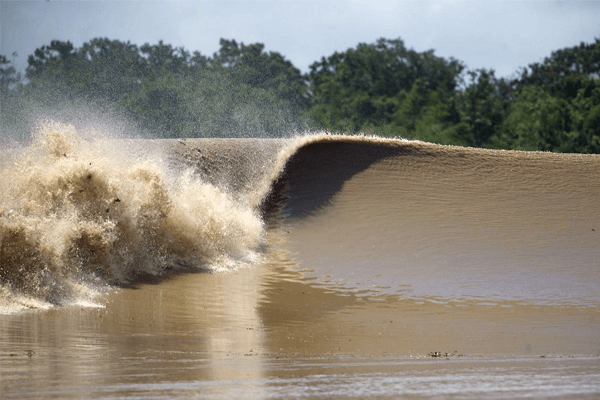Pororoca: The wave that transforms rivers and ecosystems in the Amazon
What is it and how does it happen?
Have you ever heard of Pororoca? This impressive natural phenomenon occurs when the flood tide invades the course of some rivers and some coastal environments with great force. Due to the tide's expressive energy about the fluvial force and the space it propagates, it can displace large amounts of water mass, which can advance for kilometers upstream! Its name is Tupi-Guarani origin and means "big noise". It plays a fundamental role in the balance of the Amazon's rivers and ecosystems
Dangerous and fascinating, the pororoca can be wild especially for small boats due to its force, which changes the river speed in seconds. At the same time, it is a great tourist attraction with impressive waves that attract surfers and visitors to enjoy this natural spectacle.
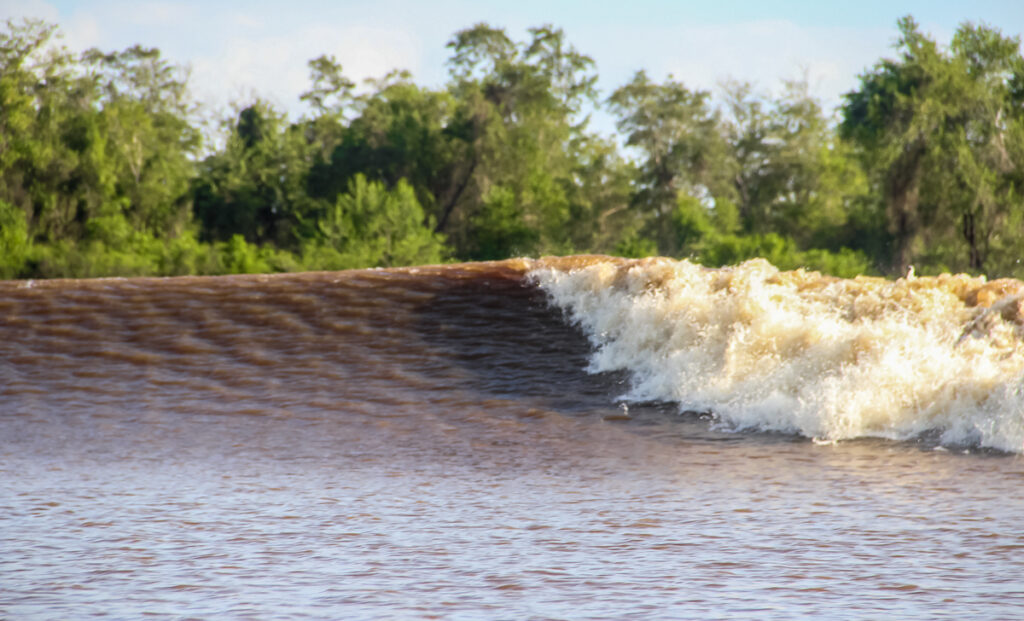
Figure 1. Pororoca. Available at: https://portalamazonia.com/amapa/pororocas-saiba-em-quais-lugares-da-amazonia-o-rio-encontra-o-mar/ https://portalamazonia.com/amapa/pororocas-saiba-em-quais-lugares-da-amazonia-o-rio-encontra-o-mar/
Moreover, the Pororoca plays a major role in moving sediment and making nutrients and oxygen available, influencing the formation of sandbanks, water quality, and the distribution of fish species and other aquatic organisms, and is considered essential for creating habitats in rivers and coastal areas, as well as shaping the environment for the reproduction of animals that are adapted to the event.
The wave that shapes the river
A study conducted by researcher Adriel Carneiro from UFPA Marine Environmental Monitoring Research Laboratory (LAPMAR), analyzed the phenomenon in the Sucuriju River and showed that, after the wave passed, the speed of the water quickly reversed and doubled.
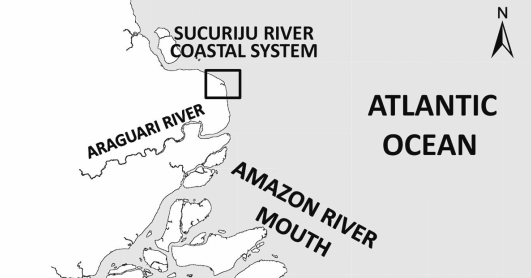
Figure 2 Map of the location of the monitoring carried out in the research Available at: https://doi.org/10.1016/j.rsma.2024.103721. https://doi.org/10.1016/j.rsma.2024.103721.
More than 70 occurrences were recorded in 03 months of monitoring the Amapa River. These sudden changes in the speed of the current and the energy of the system are demarcated by a "Hydraulic Jump", which is the hypothetical speed of propagation of this wave, considering only the differences in height. One of these recordings captured the change in the hydraulic jump speed from 1.97 m/s to 4.81 m/s in just 30 s, more than doubling the speed!
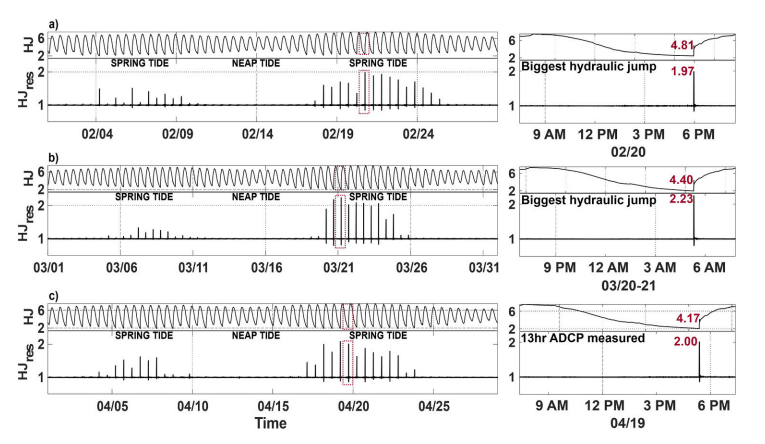
Figure 3 - Graphical representation of hydraulic jumps. Available at: https://doi.org/10.1016/j.rsma.2024.103721 https://doi.org/10.1016/j.rsma.2024.103721
In addition, the study showed that the Pororoca generates turbulence that impacts the local ecosystem, and in Sucuriju it is classified as a breaking bore at the mouth of the river and as an undular bore at the river head, with well-demarcated secondary waves (whelps). This phenomenon acts as a river shaper, influencing the distribution of nutrients, organisms, and sediments.breaking bore” ou onda quebrada na foz do rio, que remete à uma onda de maré que quebra bruscamente, e como “undular bore” ou onda ondulada, mais na cabeceira do rio, com ondas secundárias bem demarcadas (whelps). Esse fenômeno atua como um modelador do rio, influenciando a distribuição de nutrientes, organismos e sedimentos.
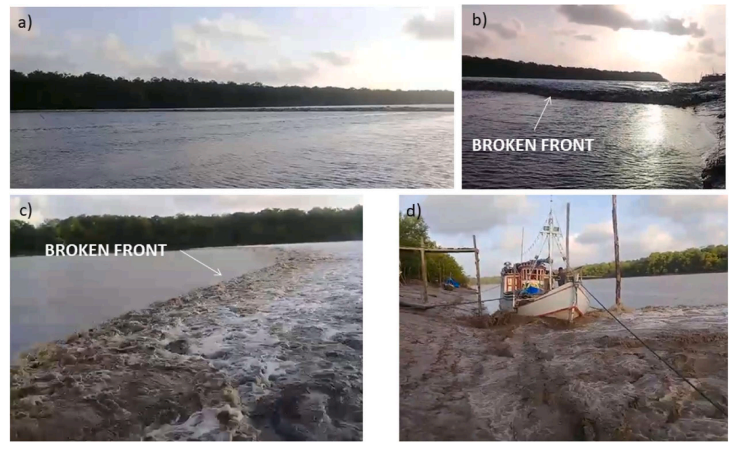
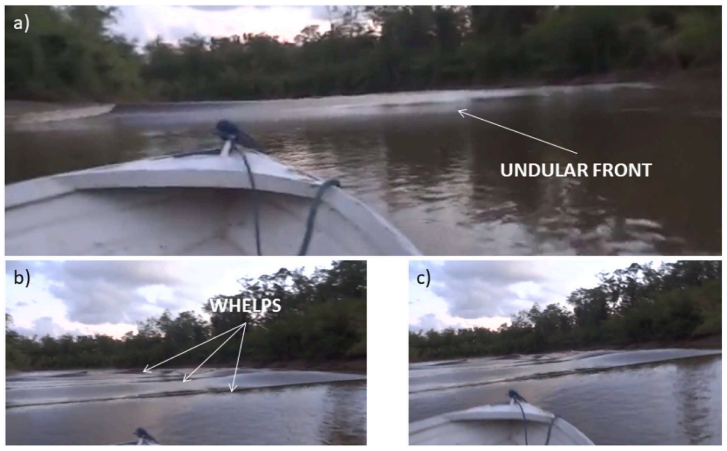
Figure 4 - Image of the mouth, on the left, and upstream, on the right, of the research monitoring river. Available at: https://doi.org/10.1016/j.rsma.2024.103721 https://doi.org/10.1016/j.rsma.2024.103721
Adriel adds that the phenomenon occurs in several different environments abroad but always in the transition zone between marine and terrestrial environments. Much more than just the "meeting of the river and the sea", the pororoca is a complex phenomenon that does not necessarily demarcate the meeting of these waters but demonstrates how this great force and energy of the tidal wave can completely shape the environment around it, govern the hydro-sedimentary and biochemical dynamics of the place, as well as dictating the migration of various populations of organisms.
References
CARNEIRO, A. G.; ROLLNIC, M. Hydrodynamic and turbulence associated with tidal bore propagation in an amazonian macrotidal system. Regional Studies in Marine Science, v. 77, p. 103721, dez. 2024.

